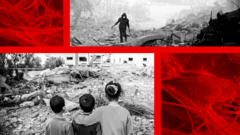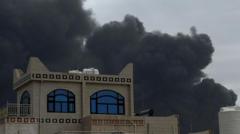As the situation in Gaza continues to evolve, experts are sounding the alarm about the health risks associated with asbestos found in the destruction caused by military actions. The long-term effects of exposure could lead to severe illnesses including cancer.
Asbestos Threat Looms over Gaza’s Ruins Amid Conflict

Asbestos Threat Looms over Gaza’s Ruins Amid Conflict
Rubble from ongoing military operations in Gaza poses a serious risk of asbestos exposure, warning health experts.
The ongoing conflict in Gaza has uprooted lives and left a toxic legacy in its wake, with experts cautioning that the debris created by military actions contains significant amounts of asbestos, a known health hazard. Once a common material in construction, asbestos is now banned in much of the world due to its carcinogenic properties.
According to the United Nations Environment Programme (UNEP), antiquated buildings in Gaza, especially those used as refugee camps since the 1948-49 Arab-Israeli War, still contain asbestos roofing. These structures, when damaged during airstrikes or conflict, release microscopic fibers into the air, creating a hazardous environment for the inhabitants. UNEP estimates that around 2.3 million tons of contaminated rubble may currently litter the region.
Professor Bill Cookson, a leading expert on mesothelioma, underscores the longevity of asbestos-related health risks, stating, "The lives lost now are not going to end here." He highlights that even minimal exposure to asbestos can have deadly repercussions, laying the groundwork for serious conditions such as asbestosis and mesothelioma, both of which manifest many years after exposure.
Dr. Ryan Hoy emphasizes the challenge of avoiding inhalation of asbestos fibers, particularly in densely populated areas where these particles can remain suspended in the air. The current humanitarian crisis means that residents lack awareness of these risks, as their immediate concerns are survival amidst ongoing violence. Chiara Lodi, a medical coordinator with Medical Aid for Palestinians, remarked that the fear of exposure to bombs outweighs the concerns over asbestos, further complicating the situation for those trying to rebuild their lives.
In light of previous conflicts, including the destruction wrought in Gaza in 2009, it is clear that debris removed from older buildings can pose a health risk due to unauthenticated asbestos content. This issue is compounded by the fact that Israel outlawed asbestos use in construction in 2011, making the remnants of aged infrastructure especially perilous.
Currently, diminishing resources hinder the response to asbestos exposure, especially regarding educating civilians about the dangers of the debris. Experts warn that the scale of destruction could result in long-term health crises much greater than the immediate fatalities from the conflict.
The potential for massive asbestos disturbance during reconstruction efforts has caught the attention of health officials and international organizations. A UNEP report cautions that these operations could exacerbate airborne asbestos risks, calling for careful management strategies. The projected cost and duration for clearing the debris is extensive, with estimates of 21 years and $1.2 billion needed for complete remediation.
As the conflict continues, it's vital to recognize that beyond the immediate casualties of war, the ongoing health risks associated with toxic debris have the potential to affect generations in Gaza. The intersection of war, public health, and environmental safety underscores the need for prompt and informed action to protect the future of Gaza's population amidst this crisis.
According to the United Nations Environment Programme (UNEP), antiquated buildings in Gaza, especially those used as refugee camps since the 1948-49 Arab-Israeli War, still contain asbestos roofing. These structures, when damaged during airstrikes or conflict, release microscopic fibers into the air, creating a hazardous environment for the inhabitants. UNEP estimates that around 2.3 million tons of contaminated rubble may currently litter the region.
Professor Bill Cookson, a leading expert on mesothelioma, underscores the longevity of asbestos-related health risks, stating, "The lives lost now are not going to end here." He highlights that even minimal exposure to asbestos can have deadly repercussions, laying the groundwork for serious conditions such as asbestosis and mesothelioma, both of which manifest many years after exposure.
Dr. Ryan Hoy emphasizes the challenge of avoiding inhalation of asbestos fibers, particularly in densely populated areas where these particles can remain suspended in the air. The current humanitarian crisis means that residents lack awareness of these risks, as their immediate concerns are survival amidst ongoing violence. Chiara Lodi, a medical coordinator with Medical Aid for Palestinians, remarked that the fear of exposure to bombs outweighs the concerns over asbestos, further complicating the situation for those trying to rebuild their lives.
In light of previous conflicts, including the destruction wrought in Gaza in 2009, it is clear that debris removed from older buildings can pose a health risk due to unauthenticated asbestos content. This issue is compounded by the fact that Israel outlawed asbestos use in construction in 2011, making the remnants of aged infrastructure especially perilous.
Currently, diminishing resources hinder the response to asbestos exposure, especially regarding educating civilians about the dangers of the debris. Experts warn that the scale of destruction could result in long-term health crises much greater than the immediate fatalities from the conflict.
The potential for massive asbestos disturbance during reconstruction efforts has caught the attention of health officials and international organizations. A UNEP report cautions that these operations could exacerbate airborne asbestos risks, calling for careful management strategies. The projected cost and duration for clearing the debris is extensive, with estimates of 21 years and $1.2 billion needed for complete remediation.
As the conflict continues, it's vital to recognize that beyond the immediate casualties of war, the ongoing health risks associated with toxic debris have the potential to affect generations in Gaza. The intersection of war, public health, and environmental safety underscores the need for prompt and informed action to protect the future of Gaza's population amidst this crisis.



















